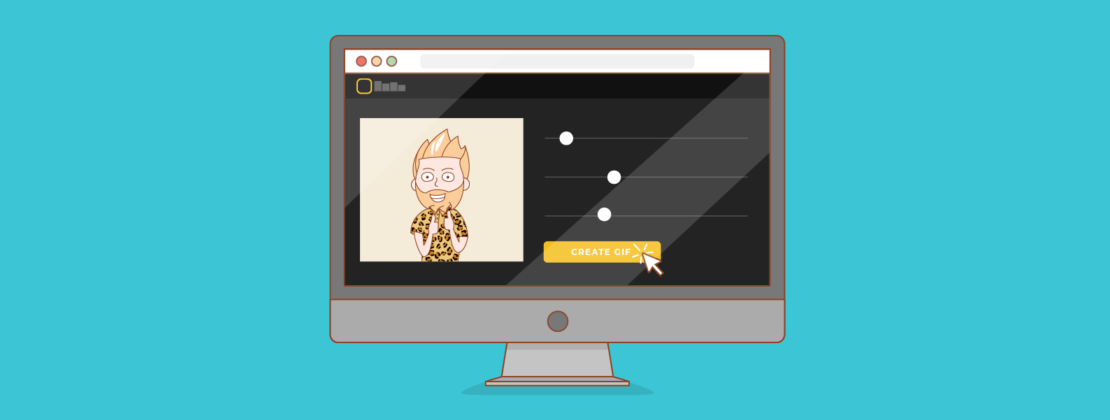People love GIFs and share millions of them every single day! These short animations replace thousands of words when messaging and open up new possibilities for business. Being brief and lively, GIFs attract users and direct their attention.
Read on to figure out the benefits of using GIFs in emails, online and offline tools that can help you create them, as well as how to embed a GIF in an email with SendPulse.
Content:
- Benefits of using GIFs in emails
- Considerations when using GIFs in emails
- Mailboxes support
- GIFs size
- Accessibility issues
- Copyright
- How to create a GIF for emails online
- Create a GIF with MakeAGIF
- Create a GIF with Giphy
- Create a GIF with Gifpal
- Create a GIF from a YouTube video
- How to create a GIF for emails offline
- Make a GIF in Photoshop
- Make a GIF in Photoscape X
- How to create a GIF for emails on your phone
- GIF Maker
- Giphy
- How to embed a GIF in an email
- Examples of GIFs in email campaigns
- Conclusion
Benefits of using GIFs in emails
Technically, a GIF is an image format, but — unlike a JPG or PNG — it contains several images that are displayed one after another to create the illusion of motion. This illusion makes GIFs an excellent alternative to videos, which can be tricky to use in email campaigns.
Here are some of the key reasons why GIFs are an email marketer’s friend:
- GIFs draw attention. Compared to static images and text, GIFs attract more attention and make your message easier to understand. For instance, to encourage people to cut back on using plastic, one could send them an email with convincing text about the dangers of plastic. But, an expressive GIF at the top of the email is what will make subscribers read it.
- GIFs increase the click rate. Interactive content, including GIFs, increases click-to-open rates by 73%. The simplest case is when an animated GIF in an email makes CTA buttons more visible by shimmering or blinking. With creative use, GIFs can tease the audience, provoking a click. For example, showing the first moments of unboxing a new product may trigger a sense of intrigue and get your subscribers to click through to your website out of curiosity.
- GIFs help show a product’s functionality. 80% of consumers consider video content useful for understanding an offer. In email campaigns, marketers often replace it with GIFs to give a quick glance at new products, service functionality, or application features. It could be photos of a new model of headphones from different angles, a screen recording of a task-tracking application, or moving infographics about warranty service operation.
Considerations when using GIFs in emails
There are a few pitfalls to avoid when using GIFs for your emails.
Mailboxes support
Don’t worry: the top-three most popular email clients — Apple iPhone, Gmail, and Apple Mail — support GIFs. The same holds true for almost all desktop, web-based, and mobile platforms. The only thing to be concerned about is that Outlook 2007, 2010, and 2013 only display the first frame of the animation. Hence, to be safe, you’d better put the most meaningful information, like your CTA or headline, in the first frame.
GIFs size
Make sure your GIF is under 1MB in size because desktop users with slow connections and mobile users account for as much as 49% of all opened emails. The larger the file size, the longer it will take to load fully, and your subscribers may scroll down without seeing it.
Fortunately, there are dozens of services to compress a GIF, to name a few:
Note! If you need to convert a video to GIF format without editing, use Online Converter.
Besides, pay attention to the width of your GIF. Most emails are 600 pixels wide, be sure to keep your GIF’s width under this. If your email template has multiple columns, reduce the GIF’s dimensions accordingly. For example, if there are two equal columns, the GIF should be 300 pixels.
Accessibility issues
Visual impairment may cause difficulties for viewing animated content and a high frame rate and flashing can trigger seizures. So, make sure to limit flashing to three times per second, avoid high-contrast transitions and red flashes.
To make your email accessible for screen reader users, use alternative text with your GIFs.
Copyright
GIFs as other images are subject to copyright like any other piece of creative work. However, there are no clear guidelines for the do’s and don’ts of their lawful use. Here are some rules of thumb to follow:
- Don’t use GIFs from untrusted sources
- Make sure not to insult the author, viewer, or the one depicted in the animation
- Ask for permission from the author
- Credit the author
The best solution is to create your own GIFs.
How to create a GIF for emails online
Now that you know why GIFs are so useful in email campaigns, you might be ready to get crafty and create your own animation. Below you’ll find our guide to using four different online GIF makers.
Create a GIF with MakeAGIF
MakeAGIF is a universal GIF solution that allows you to create animations from YouTube and Facebook videos, your webcam, or uploaded images and videos. It’s a cool tool if you need to make a GIF quickly and with little editing: just adjust the length of the animation, add text, emoji, and some simple effects.
To make a GIF from a YouTube video, add a link to it and the processing will begin immediately:
MakeAGIF is easy to use, as all the processing is performed in a single step. However, the free version has some limitations:
- only low and medium resolution GIFs;
- maximum GIF length of 20 second.
To use enhanced features, you have to upgrade to Premium account for $12 per month with a 3-day free trial available.
Create a GIF with Giphy
Giphy, a free GIF editor, allows you to create an animation from multiple photos, uploaded GIFs or videos, links to YouTube or Vimeo videos, or from Giphy library. The good thing about this GIF maker is that there’s no watermark added to GIFs you create.
Let’s see how to make a GIF with Giphy:
Upload your file and edit it: add captions, filters, and stickers. You can even draw something to add to your GIF. Finally, enter tags and give a link to the original GIF, if any. After that, your GIF can be uploaded to Giphy.
There are two ways to use your new GIF: either download it by right-clicking and selecting “Save as,” or share by copying the link. Besides a standard link, there are special links for sharing your GIF on social media and code for embedding it to your website.
Create a GIF with Gifpal
Gifpal is a free online service for creating GIF animations from images. Choose the desired size of your GIF, upload frame images one by one, adjust their length and order, and save the result:
The only limitation of the service is that there is a small “GIFPAL” watermark in the right corner.
Create a GIF from a YouTube video
If you are going to create GIFs from YouTube videos, you don’t even have to switch to another website. Open the video page, enter the word “gif” in front of “youtube” in the address bar.
Like this: www.youtube.com/watch… → www.gifyoutube.com/watch….
Press “Enter” to go to the GIF editor at gifs.com. Here you can add captions, stickers, and different effects to your GIF. You can change the color, brightness, add blurring, set padding areas, as well as horizontal and vertical flip.
When you finish your adjustments, create the GIF. You can’t remove the watermark — a pop-up with Drake appears and offers a paid version from $ 1.99 per month. In the last step, choose whether your GIF is public or private. You can download the final file in two sizes: original or compressed. Otherwise, you can copy the link and share it on social media or embed the GIF to your website.
At Gifs.com, you can edit videos that you upload, and videos from Vine and Instagram. These features are available on the main page. To go there, click on the gifs icon in the upper left corner of the page.
Note! SendPulse allows you to make a GIF from a YouTube video and immediately embed it in your email — read the instructions in our knowledge base. This method works if your video is 100 MB or less.
How to create a GIF for emails offline
You can make a GIF using various offline software as well. Although installing software is not always convenient, it allows you to get a GIF of any size and resolution, moreover, without a watermark.
Make a GIF in Photoshop
With Photoshop, you can make a GIF from images or video. Let’s have a look at both options.
To make a GIF from images in Photoshop, start by creating a new file. Import the images you need for your future GIF: each frame of your GIF needs to be a separate layer. Then go to Window > Timeline. A new panel with the Create video timeline button will appear:
- Click the arrow on the button to see the drop-down menu.
- Select Create frame animation to change the button function.
- Click the button to create the first frame.
Once the first frame appears on the timeline, set the duration for it and leave only the necessary layer visible. Copy the finished frame as many times as you need.
Save your GIF by choosing File > Export > Save for Web.
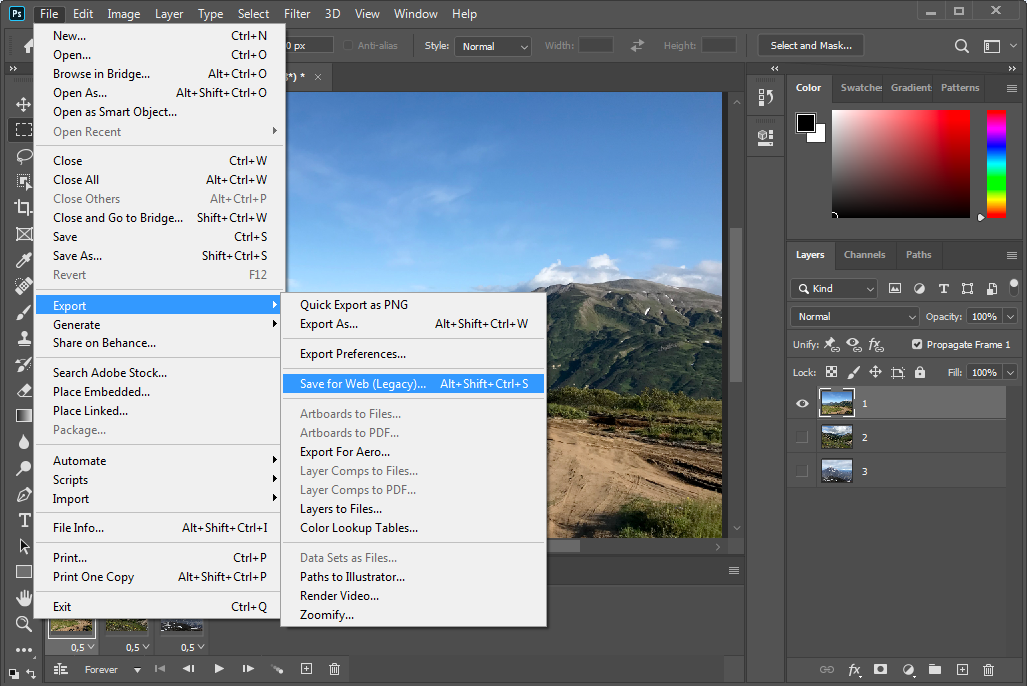
Set up the export parameters. Choose the type of file you’d like to save: they differ in quality and, accordingly, in size. You can reduce the size of the selected version by limiting the number of colors and the file’s width and height.
Make sure that you indicate GIF as the output file format and select Forever in the Looping options drop-down menu.
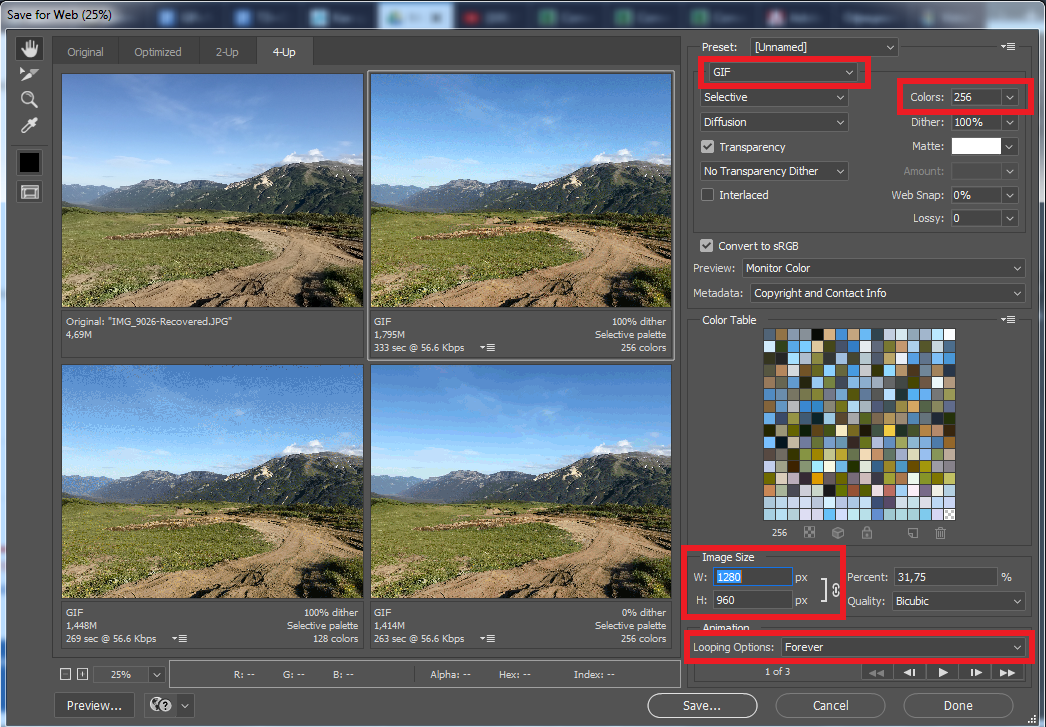
To make a GIF from video in Photoshop, make sure you upload small-weight files, 50 MB or less is ideal. It will take the program much longer to process larger files.
Create a new file and go to File > Import > Video frames to layers.
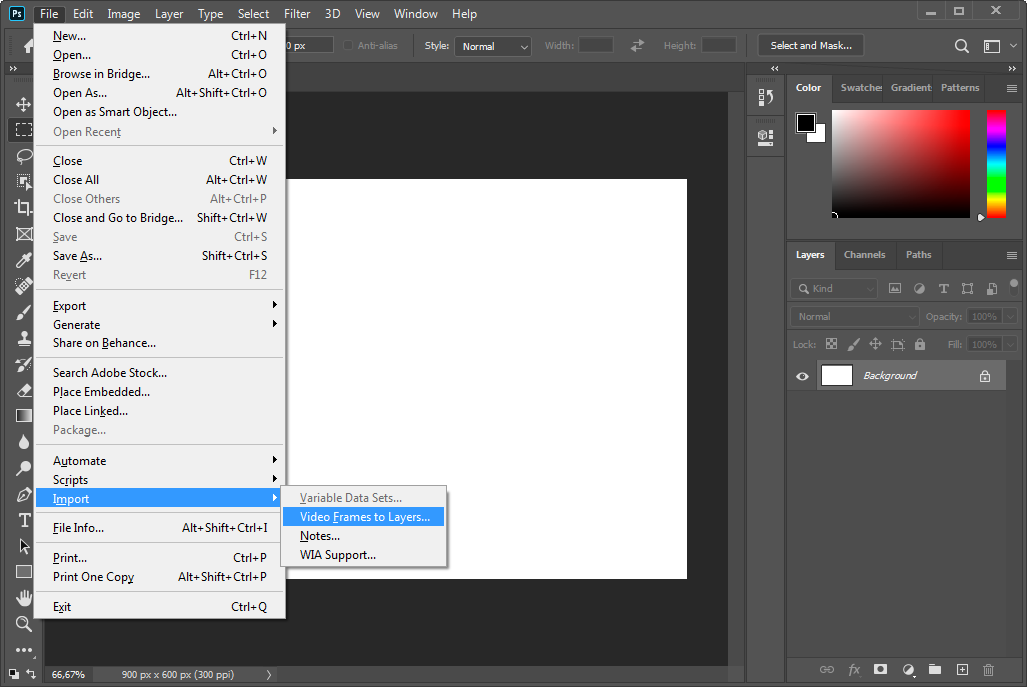
Once the video is chosen, an import window will appear. Select whether you want to import the whole video or part of it. It’s better to choose longer sections of videos, as you can remove extra frames to shorten the length of your GIF. To make your GIF smaller, tick the Limit to every X frames checkbox: if you put 2 in the empty field, there will be two times fewer frames than in the original file; if you put 3, the number of frames will be reduced threefold. This will not affect the quality much; however the GIF won’t be as smooth as the original video. Finally, tick the Make frame animation option.
Here is a sample of settings:
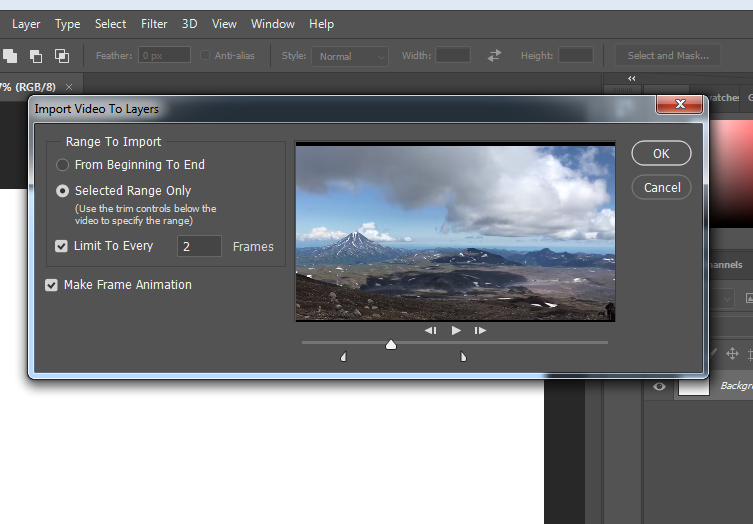
Next, repeat the same steps you made when creating GIFs from images. Open up the Timeline panel, the frames will already be there:
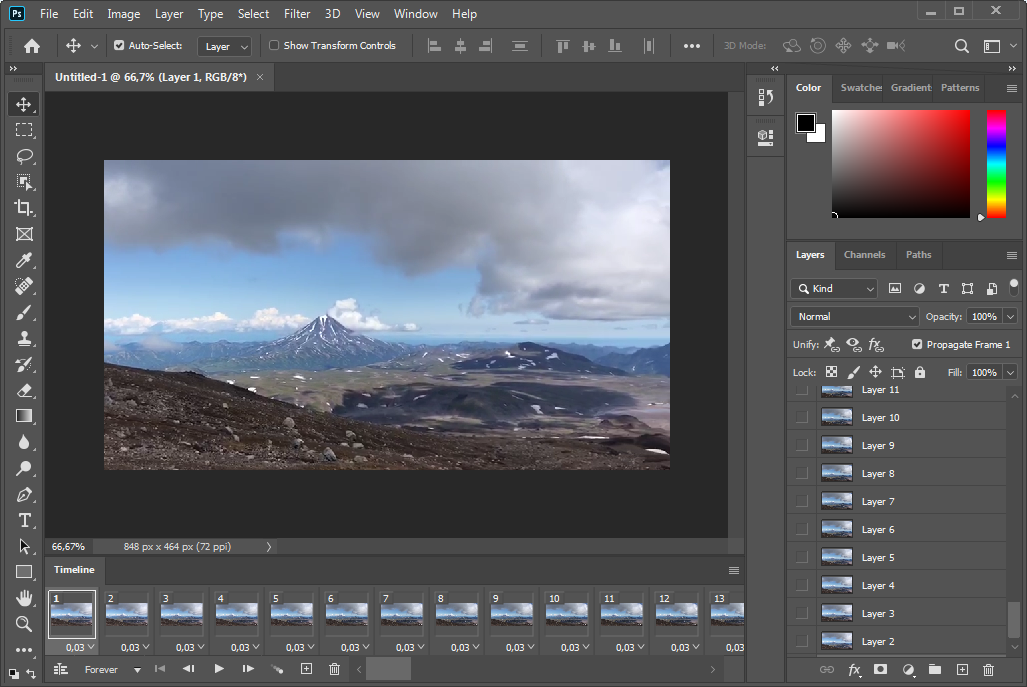
Edit the frames as you wish: change their duration or remove unnecessary frames. You can also add more images or text to the frame sequence. Save the file via File > Save for Web.
Make a GIF in Photoscape X
You can create a simple GIF from images on macOS or Windows 10 with the free version of Photoscape X.
Photoscape X is convenient to use because it’s image editor is more user-friendly than Photoshop. You can crop images, adjust their color, make a collage, or add text, arrows, and other objects.
To create a GIF from images using Photoscape X, choose the desired size of the GIF in the menu on the right. Drop images into the editor window and put them in the desired order. The next step is to adjust the duration of each frame and the transitions between them. Finally, click on the Save button in the lower right corner and set the looping parameter.
How to create a GIF for emails on your phone
There are two options if you want to convert images and videos into GIFs on your phone, depending on whether it’s iOS or Android.
GIF Maker
GIF Maker will help you make a GIF on Android. This application can process images, videos, and screen captures:
The application has a curious pricing policy: almost every feature is available on the free plan. The catch is that you cannot undo steps when editing: there is no undo / redo button. Also there is a tremendous amount of advertising in a free account. For $2.99, you can purchase a premium version with no limitations or advertising.
Giphy
This is a free mobile application for both Android and iOS powered by Giphy’s online service. You can make a GIF from files on your phone or by taking photos and videos directly in the application.
To create a GIF, click on the plus icon in the bottom menu. The camera will open; If you want to take a photo, tap the circle; if you want to record a video, hold the circle and release it when you’re done. If you want to use files from your phone, click on the gallery icon.
The mobile application offers the same editing features as its web version: captions, filters, and stickers. You can download the resulting file as a video or GIF, as well as upload it to the Giphy library.
How to embed a GIF in an email
With the SendPulse Drag and Drop Editor, you can embed a GIF in your email as a “Picture” element. Open the editor, drag and drop the “Picture” element into your template. Then add your GIF by clicking the upload button or directly dropping the file.
Be sure to add alt-text to your GIF so that your subscribers understand the message even if the GIF is not displayed. You can also add a link to it.
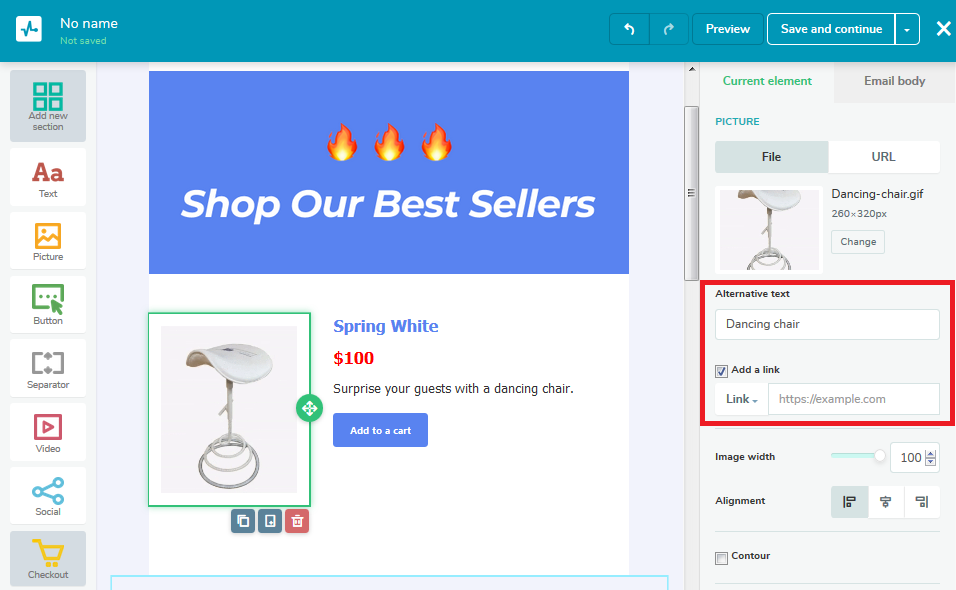
Examples of GIFs in email campaigns
Ready to add GIFs to your emails? Need some inspiration? Let’s look at some real-life use cases to fuel up your creativity.
As mentioned, GIFs are often used in email campaigns to highlight the features of a product or service. Below you can see an email by Sprout Social introducing one of its new tools, a publishing calendar. Right after the CTA offering a trial period, there is a GIF showing the calendar in action. A subscriber sees familiar social media icons and a calendar grid and instantly understands the subject matter.
The same idea applies to more complicated cases, as well. SM Contact demonstrates their circuit board production technology with a GIF to bolster their customers’ understanding of the product.
GIFs also help to set the mood for an email. For instance, Grammarly uses animated icons in their weekly emails to playfully express the number of words the user has checked with the help of their service.
By drawing attention to the main subject of the email, GIFs can trigger clicks. The email below by Hootsuite offers their social media trends report, illustrating it with an animated banner. Those who click on the banner arrive at a landing page for a webinar on the top 5 social media insights of 2020.
Conclusion
A GIF is midway between an image and video used to grab user attention, break down complicated topics, and even boost conversions.
To use GIFs in your emails in the right way:
- add your CTA or header to the first frame of your GIF to make it the most informative;
- limit the weight of your file to 1MB and its width to 600px;
- avoid frequent blinking or flashing;
- respect copyrights.
To create a GIF for your email, turn to:
- web-based tools;
- offline software for your computer;
- mobile applications.
We hope you are ready and inspired to add a little motion to your email campaigns Sign up with SendPulse to quickly add GIFs to your templates and delight your subscribers.
